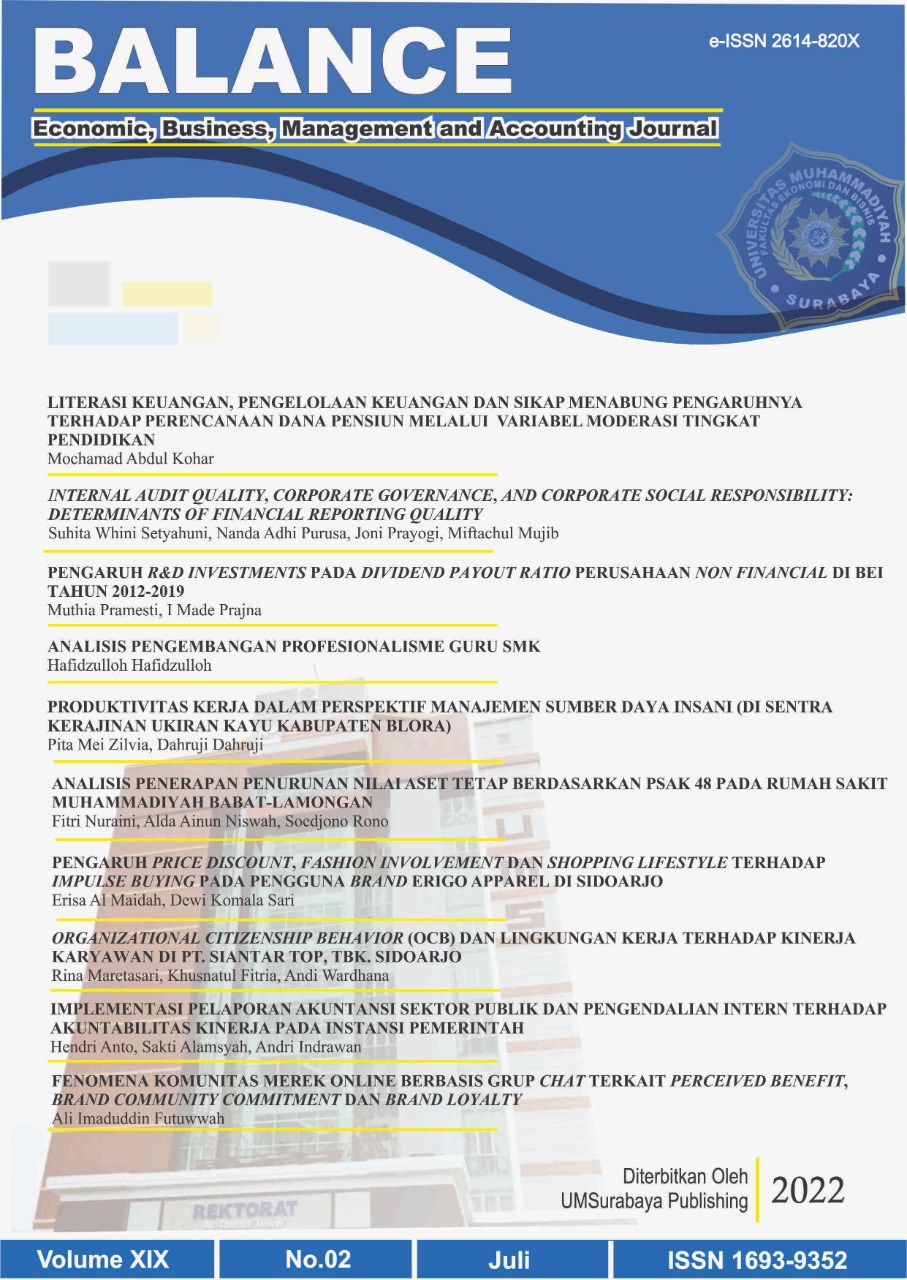Fenomena Komunitas Merek Online Berbasis Grup Chat Terkait Perceived Benefit, Brand Community Commitment Dan Brand Loyalty
DOI:
https://doi.org/10.30651/blc.v19i2.13899Kata Kunci:
brand loyalty, brand community commitment, group chat, perceived benefit, photography community, komitment komunitas merek, loyalitas merek, chat grup, manfaat yang dirasakan, komunitas fotografiAbstrak
ABSTRACTÂ
Â
The development of technology and the internet makes the brand community proliferate by using online media known as online-based brand communities, whose reach is getting wider. This study discusses members' benefits when interacting in community chat groups. When members feel the benefits, members will have a solid commitment to the community and encourage brand loyalty. This research will use the SONY APLHA photography community. The sample was taken from as many as 186 respondents are community members who are members of WhatsApp and Telegram chat groups. The analytical tool used is SMART PLS 3.0. The research findings explain that not all benefits obtained by community members can create a commitment to the community. Only hedonic and social benefits have a positive effect on member commitment. Community commitment positively impacts brand loyalty because members continue to be involved in the brand community. This research has implications for brand community managers to pay attention to activities that support benefits for members because it will create member commitment to continue to survive in the community.
ABSTRAK
Berkembangnya teknologi dan internet membuat komunitas merek berkembang dengan pesat dengan menggunakan media online yang dikenal sebagai komunitas merek berbasis online yang jangkauannya semakin luas. Penelitian ini membahas manfaat yang dirasakan anggota ketika berinteraksi di grup chat komunitas. Ketika anggota merasakan manfaatnya, anggota akan memiliki komitmen yang kuat terhadap komunitas dan mendorong loyalitas merek. Penelitian ini akan menggunakan komunitas fotografi SONY APLHA. Sampel yang diambil sebanyak 186 responden merupakan anggota komunitas yang tergabung dalam grup chat WhatsApp dan Telegram. Alat analisis yang digunakan adalah SMART PLS 3.0. Temuan penelitian menjelaskan bahwa manfaat yang diperoleh anggota komunitas tidak semua dapat menciptakan komitmen terhadap komunitas hanya manfaat hedonis dan sosial berpengaruh positif terhadap komitmen anggota. Komitmen komunitas berpengaruh positif terhadap loyalitas merek karena anggota terus terlibat di komunitas merek. Penelitian ini memberikan implikasi bagi pengelola komunitas merek untuk meperhatikan aktivitas yang mendukung manfaat bagi anggota karena akan menciptakan komitmen anggota agar terus bertahan di dalam komunitas.
Referensi
Aikens, K. A., Astin, J., Pelletier, K. R., Levanovich, K., Baase, C. M., Park, Y. Y., & Bodnar, C. M. (2014). Mindfulness Goes to Work: Impact of an Online Workplace Intervention. Journal of Occupational and Environmental Medicine, 56(7), 721–731. https://doi.org/10.1097/JOM.0000000000000209
Chen, L., Yuan, L., & Zhu, Z. (2021). Value co-creation for developing cultural and creative virtual brand communities. Asia Pacific Journal of Marketing and Logistics, (72091313). https://doi.org/10.1108/APJML-04-2021-0253
Contiua, L. C., Gaborb, M. R., & Stefanescuc, D. (2012). Hofstede’s Cultural Dimensions and Student’s Ability to Develop an Entrepreneurial Spirit. Procedia - Social and Behavioral Sciences, 46, 5553–5557. https://doi.org/10.1016/j.sbspro.2012.06.474
F. Hair Jr, J., Sarstedt, M., Hopkins, L., & G. Kuppelwieser, V. (2014). Partial least squares structural equation modeling (PLS-SEM). European Business Review, 26(2), 106–121. https://doi.org/10.1108/ebr-10-2013-0128
Futuwwah, A. I. (2020). Pengaruh Value Co-Creation Practice, Perceived Benefit Dan Brand Community CommitmentTerhadap Brand Loyalty Pada Grup Facebook Komunitas Sepeda Polygon Indonesia. UNIVERSITAS AIRLANGGA.
Futuwwah, A. I., & Mardhiyah, D. (2019). Pengaruh Praktik Social Networking, Kepercayaan Merek Dan Loyalitas Merek Pada Komunitas Merek Online. Jurnal Riset Manajemen Dan Bisnis (JRMB) Fakultas Ekonomi UNIAT, 4(3), 401–416. https://doi.org/10.36226/jrmb.v4i3.269
G Hofstede. (2011). Dimensionalizing cultures: The Hofstede model in context. Psychology and Culture, 2(1), 1–26. https://doi.org/10.9707/2307-0919.1014
Gronholdt, L., Martensen, A., & Kristensen, K. (2000). The relationship between customer satisfaction and loyalty: Cross-industry differences. Total Quality Management, 11(4–6), 509–514. https://doi.org/10.1080/09544120050007823
Hair, J. F., Black, W. C., & Anderson, R. E. (2014). Multivariate Data Analysis. London: Pearson Education Limited.
Hair, J. F., Hult, G. T. M., Ringle, C. M., & Sarstedt, M. (2014). A Primer on Partial Least Square Structural Equation Modeling (PLS-SEM). London: SAGE Publications.
Han, M., Wu, J., Wang, Y., & Hong, M. (2018). A model and empirical study on the user’s continuance intention in Online China Brand communities based on customer-perceived benefits. Journal of Open Innovation: Technology, Market, and Complexity, 4(4), 1–20. https://doi.org/10.3390/joitmc4040046
Hofstede. (2022). Country Comparison. Retrieved from https://www.hofstede-insights.com/country-comparison/indonesia/
Hur, W. M., Ahn, K. H., & Kim, M. (2011). Building brand loyalty through managing brand community commitment. Management Decision, 49(7), 1194–1213. https://doi.org/10.1108/00251741111151217
Iacobucci, D. (1994). Toward defining relationship marketing. Relationship Marketing: Theory, Methods and Applications, 89–97.
Jang, H., Olfman, L., Ko, I., Koh, J., & Kim, K. (2008). The Influence of On-Line Brand Community Characteristics on Community Commitment and Brand Loyalty. International Journal of Electronic Commerce, 12(3), 57–80. https://doi.org/10.2753/JEC1086-4415120304
Jin, B., Park, J. Y., & Kim, H.-S. (2010). What makes online community members commit? A social exchange perspective. Behaviour & Information Technology, 29(6), 587–599. https://doi.org/10.1080/0144929X.2010.497563
Jung, N. Y., Kim, S., & Kim, S. (2014). Influence of consumer attitude toward online brand community on revisit intention and brand trust. Journal of Retailing and Consumer Services, 21(4), 581–589. https://doi.org/10.1016/j.jretconser.2014.04.002
Kang, M., & Shin, D. H. (2016). The effect of customers’ perceived benefits on virtual brand community loyalty. Online Information Review, 40(3), 298–315. https://doi.org/10.1108/OIR-09-2015-0300
Kemp, S. (2022). More Than 5 Billion People Now Use The Internet. Retrieved from https://wearesocial.com/hk/blog/2022/04/more-than-5-billion-people-now-use-the-internet/
Kim, J. W., Choi, J., Qualls, W., & Han, K. (2008). It takes a marketplace community to raise brand commitment: the role of online communities. Journal of Marketing Management, 24(3–4), 409–431. https://doi.org/10.1362/026725708X306167
Kuo, Y. F., & Feng, L. H. (2013). Relationships among community interaction characteristics, perceived benefits, community commitment, and oppositional brand loyalty in online brand communities. International Journal of Information Management, 33(6), 948–962. https://doi.org/10.1016/j.ijinfomgt.2013.08.005
Lin, C. W., Wang, K. Y., Chang, S. H., & Lin, J. A. (2017). Investigating the development of brand loyalty in brand communities from a positive. Journal of Business Research, 99, 446–455. https://doi.org/10.1016/j.jbusres.2017.08.033
Luo, N., Zhang, M., & Liu, W. (2015). The effects of value co-creation practices on building harmonious brand community and achieving brand loyalty on social media in China. Computers in Human Behavior, 48, 492–499. https://doi.org/10.1016/j.chb.2015.02.020
Manuwu, P. (2018). Grup Chat Komunitas Online Kini Mulai Bermunculan di Indonesia. Retrieved from https://id.techinasia.com/grup-chat-komunitas-online
McAlexander, J. H., Schouten, J. W., & Koenig, H. F. (2002). Building Brand Community. Journal of Marketing, 66(1), 38–54. https://doi.org/10.1509/jmkg.66.1.38.18451
Mulia, K. (2021). After worldwide outage, will Southeast Asia’s dependence on Facebook and WhatsApp wane? Retrieved from https://kr-asia.com/after-worldwide-outage-will-southeast-asias-dependence-on-facebook-and-whatsapp-wane
Muniz, & O’Guinn. (2001). Brand Community. Research, Journal of Consumer, 27(4), 412–432. https://doi.org/10.1086/319618
Nambisan, S., & Baron, R. (2009). Virtual Customer Environments: Testing a Model of Voluntary Participation in Value Co-Creation Activities. The Journal Of Product Innovation Management, 26, 388–406. https://doi.org/10.1111/j.1540-5885.2009.00667.x
Oliver, R. L. (1999). Whence Consumer Loyalty ? Journal of Marketing, 63, 33–44.
Pool, A. K., Pool, M. K., & Manjiri, H. (2018). Effect of Brand Community Commitment on Loyalty and Brand Outcomes inIranian Samsung Mobile Users. International Journal of Behavioral Science, 13(1), 56–67.
Schau, H. J., Muñiz, A. M., & Arnould, E. J. (2009). How Brand Community Practices Create Value. Journal of Marketing, 73(5), 30–51. https://doi.org/10.1509/jmkg.73.5.30
Sicilia, M., & Palazón, M. (2008). Brand communities on the internet: A case study of Coca-Cola’s Spanish virtual community. Corporate Communications, 13(3), 255–270. https://doi.org/10.1108/13563280810893643
Wirtz, J., den Ambtman, A., Bloemer, J., Horváth, C., Ramaseshan, B., van de Klundert, J., … Kandampully, J. (2013). Managing brands and customer engagement in online brand communities. Journal of Service Management, 24(3), 223–244. https://doi.org/10.1108/09564231311326978















